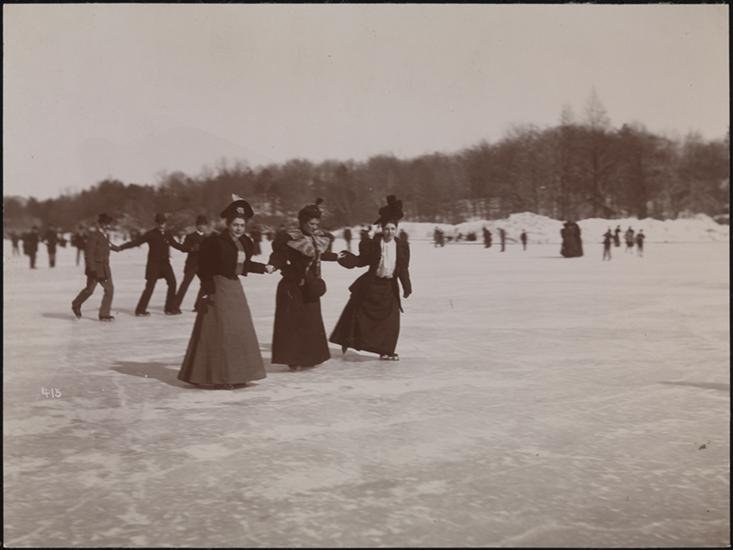History
What Made Oscar Tschirky the King of Gilded Age New York
At 6 a.m. on March 13, 1893, a 26-year-old Swiss immigrant approached the doors of the Waldorf Hotel in mid-town New York City and turned the key, opening the grand building to the public for the first time. Surrounded by clerks and elevator boys, he waited a full minute for the arrival of the first guest, a representative of William Waldorf Astor, who had razed his own Fifth Avenue home to erect the 450-room hotel but lived in London and seldom visited. From the moment the doors were unlocked, however, it was Oscar Tschirky, the longtime maître d’, who made the place tick.
Smithsonian.com, March 2018
How New York City Artists Invented a New Mode of Urban Living
The New York art scene hasn't changed much in 150 years. Fashionable women cram gallery openings. Financiers prowl studios. People queue for hours to see a painting. Parties start after midnight. And artists scramble for studio space.
Earlier generations of artists, though, were not always at war with real estate developers. They actually worked together. New buildings were once constructed just for artists; they financed some themselves. From the 1850s to the 1920s, purpose-built artist studios and apartments sprang up around Manhattan. In the process, artists—true to form—invented a new mode of urban living.
Curbed, June 2015
From Shanties to Micro Units, NYC's History of Living Small
Shanties were common in the East 20s in the 1830s and 40s, and then moved north as the city grew. According to the New York Times in 1864, "there is a population of 20,000 on this island that pay neither rent for the dwellings they occupy, nor municipal taxes as holders of real estate. They comprise that portion of the population known as 'squatters'." There were probably even more than that, especially if you counted those paying rent to land speculators who held their property until prices went up. The shantytowns looked like poor rural villages, often located on little hills. Houses were surrounded by picket fences, with muddy footpaths between them, and cows, pigs, or chickens outside.
Curbed, February 2015
How Ice Skating Made Fifth Avenue a Fashionable Destination
When Central Park opened, upper Fifth Avenue was rural and remote. Ponds and streams dotted the area around 59th Street. Unpaved roads were lined with cattle yards and stables. Saks was far in the future. Yet fashionable New Yorkers still trekked north from Washington Square—to go ice skating.
In the 1860s, when the neighborhood tipped from sylvan to stylish, private skating ponds led the charge. They lured the elite with costume balls, fireworks, music, spacious restaurants, and selective membership. Two ponds were located across the street from one another at 59th Street and Fifth Avenue, where the Plaza Hotel and Apple Store now stand, and another at 46th and Fifth, now a Guess store. Skating there was the highlight of the winter social season.
Curbed, January 2015
The Whiskey Wars that Left Brooklyn in Ruins
It looked like a storm had swept through the industrial Brooklyn neighborhood of Vinegar Hill. Whiskey ran through the cobblestones and pooled near the Navy Yard gate. Alleys were strewn with rocks, coal and scraps of wood. Molasses stuck to the streets and the air reeked of sour mash. The remains of some 20 illegal distilleries lay in ruin for all to see, abandoned in mid-production like an unfinished feast. It wasn’t a hurricane or an industrial explosion. It was a raid ordered by the newly formed Bureau of Internal Revenue, the precursor to the IRS.
Two thousand soldiers had just attacked the neighborhood, targeting moonshiners who were evading taxes on a colossal scale.
Smithsonian.com, November 2014
The Gilded Age Origins of New York City’s Rooftop Gardens
We're seemingly in a golden age of the rooftop, thanks to the likes of Brooklyn Grange and Rooftop Films. But one look through the archives and it's clear that our Gilded Age predecessors had us beat. On city rooftops a century ago, you'd find acrobats, grottoes, Russian swans, monkeys, cows, waterfalls, duck ponds, lobster Newburg, vine-wrapped arches, pagodas, and Herr Techow and his performing cats. There was even, yes, an actual rooftop farm—with fresh eggs delivered to tenants—at the Ansonia Hotel.
Rudolph Aronson, a composer and producer, came up with the idea of urban rooftop terraces. He wanted to replicate the garden theaters he'd seen in Europe but knew there was no space for them in Manhattan.
Curbed, June 2014
How Charles Dickens Saw London
Seven Dials, in central London, is a good place to people-watch. Outside the Crown pub, ruddy men laugh loudly, sloshing their pints; shoppers’ heels click on cobblestones; and tourists spill bewildered out of a musical at the Cambridge Theatre. A column marks the seven-street intersection, and its steps make a sunny perch for gazing on the parade.
Charles Dickens soaked up the scene here too, but saw something utterly different. Passing through in 1835, he observed “streets and courts [that] dart in all directions, until they are lost in the unwholesome vapour which hangs over the house-tops and renders the dirty perspective uncertain and confined.” Seven Dials was synonymous with poverty and crime, a black hole to most Londoners. Dickens stormed it with pen and paper.
Smithsonian.com, June 2011




